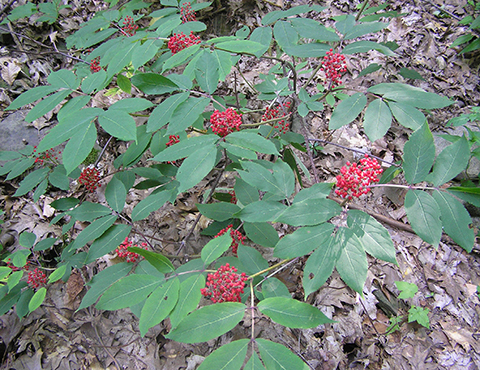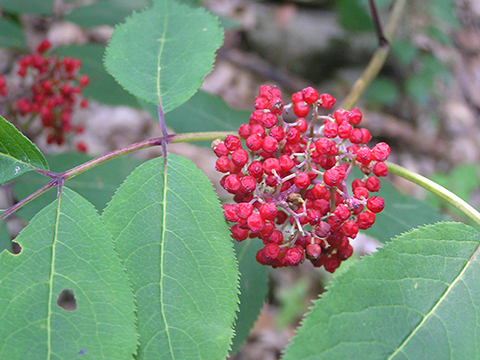 |
| Home | Ordering By Mail | Purchase Manual: Using Native Plants in Urban Landscapes |
|
|||||
Species Name: Sambucus racemosa
Common Name: Red elderberry
Zone: 3 to 8
Distribution: Found throughout Canada and the northern states from east coast to west coast and south to Tennessee.
Seed collection: Red elderberry flowers in spring about the middle of May in upstate NY. The fruit develops in open clusters turning a light green
to scarlet red as the fruit ripens in late June to early July. The seed matures before the fruit fully ripens. Mature seed develops a hard seed coat
which delays germination so seed collected early will have a higher percentage of germination. Strip the fruits from the clusters by hand
or cut the entire cluster from the plant with shears. Open grow plants flower more profusely and produce more fruit than plants growing in shade.
Seed handling: Mature seed develops a hard seed coat which delays germination so seed collected early will have a higher percentage of germination.
After collecting strip the fruit from the stems. Fruit can then be macerated either by hand or in a food processor or blender.
Add water and blend until pulp is pureed. Float off the pulp and skins with several changes of water. Heavy sound seed will sink to the bottom.
Many of the seed that float off with the pulp will still be viable so these can still be used to establish plants in the wild.
Once the seed is separated from the pulp place the seed under moist stratification. The seed should be stored this way until ready to plant
either in the fall or in the spring. Subject the seed to outdoor temperatures over the winter to vernalize the seed or place in a refrigerator for a couple of months before spring.
It is so easy to collect large quantities of fruit and therefore large numbers of seed that the problem is usually what to do with it all.
Germination requirements: The seed germinates readily the first spring when cold moist stratified. The seed is so small and it is so easy to collect large quantities of seed
that it is hard to determine how much seed to sow or what percentage of seed actually germinated. It is safer to over sow than under sow
and a sufficient number of seedlings are usually the result. Seed are tiny and seedlings are very small when they germinate
so good weed control and horticultural practices are necessary to produce large vigorous seedlings by fall. When planting under natural conditions,
seed can be fall sown or spring planted. N the wild sow seeds on top of lightly loosened natural soil, firm the seed with ones foot
to make contact with the soil and cover lightly with leaf litter.
Ecology: Red elderberry is a large sprawling shrub growing up to 15 ft tall and wide, normally found in the understory of open deciduous forests.
It can grow in dry to moist soils in full shade to full sun. It flowers in early spring producing rounded clusters of red fruits that are quickly consumed by birds.
The stems are hollow pithy and not very strong. Red elderberry is a very desirable wildlife shrub for the cover and fruit it produces.

Fruit clusters of red elderberry

Elderberry fruit ready for harvest.
this page posted February 25, 2015